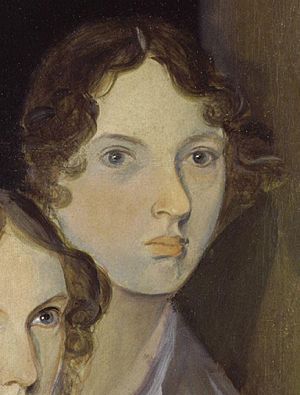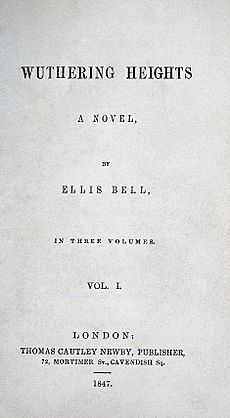Emily Brontë facts for kids
Quick facts for kids
Emily Jane Brontë
|
|
|---|---|

The only undisputed portrait of Brontë, from a group portrait by her brother Branwell
|
|
| Born | 30 July 1818 Thornton, West Riding of Yorkshire, England |
| Died | 19 December 1848 (aged 30) Haworth, West Riding of Yorkshire, England |
| Pen name | Ellis Bell |
| Occupation |
|
| Nationality | English |
| Genre |
|
| Literary movement | Romantic Period |
| Notable works | Wuthering Heights |
| Relatives | Brontë family |
Emily Jane Brontë (30 July 1818 – 19 December 1848) was an English novelist and poet who is best known for her only novel, Wuthering Heights, now considered a classic of English literature. Emily was the third-eldest of the four surviving Brontë siblings, between the youngest Anne and her brother Branwell. She wrote under the pen name Ellis Bell.
Contents
Early life and education

Emily Brontë was born on 30 July 1818 in the village of Thornton on the outskirts of Bradford, in the West Riding of Yorkshire, in Northern England, to Maria Branwell and an Irish father, Patrick Brontë. She was the younger sister of Charlotte Brontë and the fifth of six children. In 1820, shortly after the birth of Emily's younger sister Anne, the family moved eight miles away to Haworth, where Patrick was employed as perpetual curate; here the children developed their literary talents.
After the death of their mother on 15 September 1821 from cancer, when Emily was three years old, the older sisters Maria, Elizabeth and Charlotte were sent to the Clergy Daughters' School at Cowan Bridge, where they encountered abuse and privations later described by Charlotte in Jane Eyre. At the age of six on 25 November 1824, Emily joined her sisters at school for a brief period. When a typhoid epidemic swept the school, Maria and Elizabeth caught it. Maria, who may actually have had tuberculosis, was sent home, where she died. Emily was subsequently removed from the school, in June 1825, along with Charlotte and Elizabeth. Elizabeth died soon after their return home.
The three remaining sisters and their brother Patrick Branwell were thereafter educated at home by their father and aunt Elizabeth Branwell, their mother's sister. A shy girl, Emily was very close to her siblings and was known as a great animal lover, being especially noted for befriending the stray dogs she found wandering around the countryside. Despite the lack of formal education, Emily and her siblings had access to a wide range of published material; favourites included Sir Walter Scott, Byron, Shelley, and Blackwood's Magazine.
In their leisure time the children began to write fiction at home, inspired by a box of toy soldiers Branwell had received as a gift and created a number of fantasy worlds (including 'Angria') which featured in stories they wrote – all "very strange ones" according to Charlotte – and enacted about the imaginary adventures of their toy soldiers along with the Duke of Wellington and his sons, Charles and Arthur Wellesley. Little of Emily's work from this period survives, except for poems spoken by characters.
At seventeen, Emily attended the Roe Head Girls' School, where Charlotte was a teacher but managed to stay only a few months before being overcome by extreme homesickness. At this time, the girls' objective was to obtain sufficient education to open a small school of their own.
Adulthood

Emily became a teacher at Law Hill School in Halifax beginning in September 1838, when she was twenty. Her health broke under the stress of the 17-hour work day and she returned home in April 1839. Thereafter she became the stay-at-home daughter, doing most of the cooking, ironing, and cleaning. She taught herself German out of books and also practised the piano.
In 1842, Emily accompanied Charlotte to the Héger Pensionnat in Brussels, Belgium, where they attended the girls' academy run by Constantin Héger. Unlike Charlotte, Emily felt uncomfortable in Brussels, and refused to adopt Belgian fashions, saying "I wish to be as God made me", which made her into something of an outcast. The sisters planned to perfect their French and German in anticipation of opening their school. Nine of Emily's French essays survive from this period.
The two sisters were committed to their studies and by the end of the term had attained such competence in French that Madame Héger made a proposal for both to stay another half-year, even offering to dismiss the English master, according to Charlotte, so that she could take his place, while Emily was to teach music as she had by that time become a competent piano teacher. However, the illness and death of their aunt meant that they returned to Haworth and though they did try to open a school at their home, they were unable to attract students to the remote area.
In 1844, Emily began going through all the poems she had written, recopying them neatly into two notebooks. One was labelled "Gondal Poems"; the other was unlabelled. Around this time she had written one of her most famous poems "No coward soul is mine", probably as an answer to the violation of her privacy and her own transformation into a published writer. Despite Charlotte's later claim, it was not her last poem.
In 1846, the sisters' poems were published in one volume as Poems by Currer, Ellis, and Acton Bell. The Brontë sisters had adopted pseudonyms for publication, preserving their initials: Charlotte was "Currer Bell", Emily was "Ellis Bell" and Anne was "Acton Bell".
Personality and character
Charlotte Brontë remains the primary source of information about Emily, although as an elder sister, writing publicly about her shortly after her death, she is not a neutral witness.
Emily's unsociability and extremely shy nature have subsequently been reported many times. According to Norma Crandall, her "warm, human aspect" was "usually revealed only in her love of nature and of animals".
In Queens of Literature of the Victorian Era (1886), Eva Hope summarises Emily's character as "a peculiar mixture of timidity and Spartan-like courage", and goes on to say, "She was painfully shy, but physically she was brave to a surprising degree. She loved few persons, but those few with a passion of self-sacrificing tenderness and devotion. To other people's failings she was understanding and forgiving, but over herself she kept a continual and most austere watch, never allowing herself to deviate for one instant from what she considered her duty."

Wuthering Heights
Emily Brontë's Wuthering Heights was first published in London in 1847 by Thomas Cautley Newby, appearing as the first two volumes of a three-volume set that included Anne Brontë's Agnes Grey. The authors were printed as being Ellis and Acton Bell; Emily's real name did not appear until 1850, when it was printed on the title page of an edited commercial edition. The novel's innovative structure somewhat puzzled critics.
Wuthering Heights's violence and passion led the Victorian public and many early reviewers to think that it had been written by a man. According to Juliet Gardiner, "the vivid passion and power of its language and imagery impressed, bewildered and appalled reviewers." Even though it received mixed reviews when it first came out, and was often condemned for its portrayal of amoral passion, the book subsequently became an English literary classic. Emily Brontë never knew the extent of fame she achieved with her only novel, as she died a year after its publication, aged 30.
Although a letter from her publisher indicates that Emily had begun to write a second novel, the manuscript has never been found. Perhaps Emily or a member of her family eventually destroyed the manuscript, if it existed, when she was prevented by illness from completing it. It has also been suggested that, though less likely, the letter could have been intended for Anne Brontë, who was already writing The Tenant of Wildfell Hall, her second novel.
Related pages
The sisters of Emily Brontë:
The books of Emily Brontë:
- Poems by Currer, Ellis and Acton Bell (1846)
- Wuthering Heights (1847)
Images for kids
-
Portrait painted by Branwell Brontë in 1833; sources are in disagreement over whether this image is of Emily or Anne.
See also
 In Spanish: Emily Brontë para niños
In Spanish: Emily Brontë para niños



